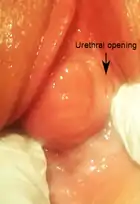Skene's gland
In female human anatomy, Skene's glands or the Skene glands (/skiːn/ SKEEN, also known as the lesser vestibular glands, paraurethral glands[1] or female homologue of the prostate) are glands located around the lower end of the urethra. The glands are surrounded by tissue that swells with blood during sexual arousal, and secrete a fluid from openings near the urethra, particularly during orgasm.
| Skene's gland | |
|---|---|
 | |
| Details | |
| Precursor | Urogenital sinus |
| Identifiers | |
| Latin | glandulae vestibulares minores |
| TA98 | A09.2.01.017 |
| TA2 | 3564 |
| FMA | 20083 |
| Anatomical terminology | |
Structure and function
The Skene's glands are located in the vestibule of the vulva, around the lower end of the urethra.[2] The two Skene's ducts lead from the Skene's glands to the vulvar vestibule, to the left and right of the urethral opening, from which they are structurally capable of secreting fluid.[2][3] Although there remains debate about the function of the Skene's glands, one purpose is to secrete a fluid that helps lubricate the urethral opening.[2][3]
The origin and production site of female ejaculation has not been proven.[4] Skene's glands produce a milk-like ultrafiltrate of blood plasma and may be the source of female ejaculation.[3][4][5] Because the Skene's gland and male prostate act similarly by secreting prostate-specific antigen (PSA), which is an ejaculate protein produced in males, and of prostate-specific acid phosphatase, some authors refer to the Skene's glands as the "female prostate".[3][5] It is homologous to the male prostate (developed from the same embryological tissues).[6][7] Female ejaculate may result from sexual activity for some women, especially during orgasm.[3][4] In addition to PSA and acid phosphatase, Skene's gland fluid contains high concentrations of glucose and fructose.[3]
In an amount of a few milliliters, fluid is secreted from these glands when stimulated from inside the vagina.[8][9] Female ejaculation and squirting (secretion of large amounts of fluid) are believed by researchers to be two different processes. They may occur in combination during orgasm. Squirting alone is a sudden expulsion of liquid that at least partly comes from the bladder and contains urine, whereas ejaculation fluid includes a whitish transparent ejaculate that appears to come from the Skene's gland.[3][10]
Clinical significance

Disorders of the Skene's glands may include:
- Infection (called skenitis, urethral syndrome, or female prostatitis)[11]
- Skene's duct cyst: lined by stratified squamous epithelium, the cyst is caused by obstruction of the Skene's glands. It is located lateral to the urinary meatus. Magnetic resonance imaging is used for diagnosis.[12] The cyst is treated by surgical excision or marsupialization.
- Trichomoniasis: the Skene's glands (along with other structures) act as a reservoir for Trichomonas vaginalis, indicating that topical treatments are not as effective as oral medication.[13]
History
While the glands were first described by the French surgeon Alphonse Guérin (1816–1895), and in 1672 by Regnier de Graaf,[14] they were named after the Scottish gynaecologist Alexander Skene, who wrote about it in Western medical literature in 1880.[15][16][17] In 2002,[7] the term female prostate as a second term after paraurethral gland was added in Terminologia Histologica by the Federative International Committee on Anatomical Terminology. The 2008 edition notes that the term was introduced "because of the morphological and immunological significance of the structure".[18]
See also
References
- "paraurethral glands" at Dorland's Medical Dictionary
- Rodriguez FD, Camacho A, Bordes SJ, Gardner B, Levin RJ, Tubbs RS (2020). "Female ejaculation: An update on anatomy, history, and controversies". Clinical Anatomy. doi:10.1002/ca.23654. PMID 32681804.CS1 maint: multiple names: authors list (link)
- Pastor Z, Chmel R (2017). "Differential diagnostics of female "sexual" fluids: a narrative review". International Urogynecology Journal. 29 (5): 621–629. doi:10.1007/s00192-017-3527-9. PMID 29285596. S2CID 5045626.CS1 maint: uses authors parameter (link)
- Greenberg, Jerrold S.; Bruess, Clint E.; Oswalt, Sara B. (2014). Exploring the Dimensions of Human Sexuality. Jones & Bartlett Publishers. pp. 102–104. ISBN 978-1449648510.
- Bullough, Vern L.; Bullough, Bonnie (2014). Human Sexuality: An Encyclopedia. Routledge. p. 231. ISBN 978-1135825096.
- Lentz, Gretchen M; Lobo, Rogerio A.; Gershenson, David M; Katz, Vern L. (2012). Comprehensive Gynecology. Elsevier Health Sciences, Philadelphia. p. 41. ISBN 978-0323091312.
- Hornstein, Theresa; Schwerin, Jeri Lynn (2013). Biology of women. Clifton Park, NY: Delmar, Cengage Learning. p. 61. ISBN 978-1-285-40102-7. OCLC 911037670.
- Castleman, Michael (2 January 2014). "Female ejaculation: What's known and unknown". Psychology Today. Retrieved 8 May 2017.
- Heath D (1984). "An investigation into the origins of a copious vaginal discharge during intercourse: "Enough to wet the bed" – that "is not urine"". The Journal of Sex Research. 20 (2): 194–215. doi:10.1080/00224498409551217.
- Salama, Samuel; Boitrelle, Florence; Gauquelin, Amélie; Malagrida, Lydia; Thiounn, Nicolas; Desvaux, Pierre (2015). "Nature and origin of "squirting" in female sexuality". The Journal of Sexual Medicine. 12 (3): 661–666. doi:10.1111/jsm.12799. ISSN 1743-6095. PMID 25545022.
- Gittes RF, Nakamura RM (1996). "Female urethral syndrome. A female prostatitis?". West J Med. 164 (5): 435–8. PMC 1303542. PMID 8686301.
- Itani M, Kielar A, Menias CO, Dighe MK, Surabhi V, Prasad SR; et al. (2016). "MRI of female urethra and periurethral pathologies". Int Urogynecol J. 27 (2): 195–204. doi:10.1007/s00192-015-2790-x. PMID 26209954. S2CID 26054797.CS1 maint: multiple names: authors list (link)
- Kissinger P (2015). "Trichomonas vaginalis: a review of epidemiologic, clinical and treatment issues". BMC Infect Dis. 15: 307. doi:10.1186/s12879-015-1055-0. PMC 4525749. PMID 26242185.
- de Graaf, Regnier (1672). De Mulierum Organis Generationi Inservientibus (in Latin). Leiden.
- Skene, A (April 1880). "The anatomy and pathology of two important glands of the female urethra". The American Journal of Obstetrics and Diseases of Women and Children. 13: 265–70.
- Skene's glands at Who Named It?
- Skene's ducts at Who Named It?
- Terminologia Histologica: International Terms for Human Cytology and Histology. Lippincott Williams & Wilkins. 2008. p. 65. ISBN 978-0781766104.
Further reading
- Pastor Z (2013). "Female ejaculation orgasm vs. coital incontinence: a systematic review". J Sex Med. 10 (7): 1682–91. doi:10.1111/jsm.12166. PMID 23634659.
| Look up skene's gland in Wiktionary, the free dictionary. |